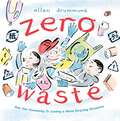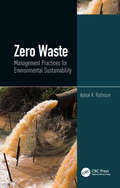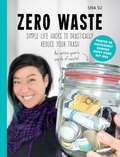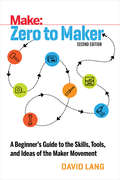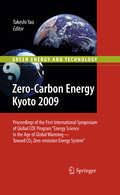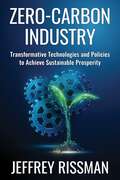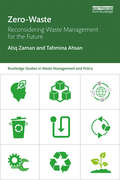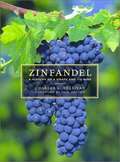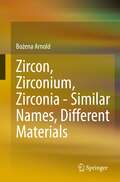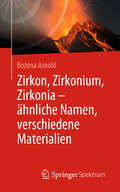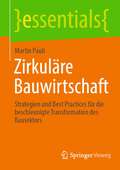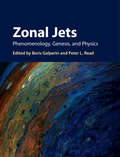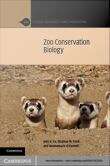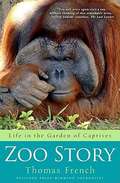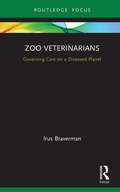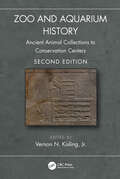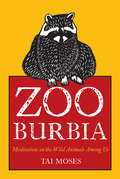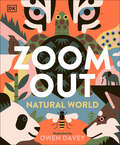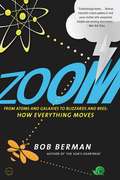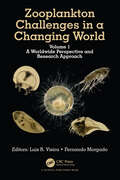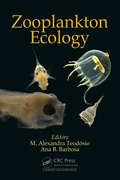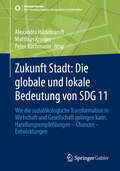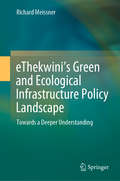- Table View
- List View
Zero Waste: How One Community Is Leading a World Recycling Revolution (Green Power)
by Allan DrummondIn this fifth installment in Allan Drummond’s picture book series about green living, a town in Japan takes a stand against its throwaway past and shows that it really does take a village to make sustainable change.Kamikatsu, Japan is known worldwide for its sanitation innovations. This small community of 1700 people is leading the way in recycling and up-cycling, and as of 2022, had nearly achieved its goal of zero waste. Told in Allan's hallmark narrative style, Zero Waste is the story of a group of citizens who dared to break out of their comfort zone and make radical change for the good of their town and the planet. Through the eyes of two children visiting their grandmother, this inspiring addition to the author’s acclaimed Green Power series about everyday communities inventing exciting new approaches to green living shows that working together for a common cause has an impact that is lasting, meaningful—and fun!
Zero Waste: Management Practices for Environmental Sustainability
by Ashok K. RathoureZero Waste: Management Practices for Environmental Sustainability presents approaches for resource management centered on reducing waste and reusing and recycling materials. It aims to save energy by reducing energy consumption associated with extracting, processing, and transporting raw materials and waste, and also to reduce and eventually eliminate the need for landfills and incinerators. This book presents the various principles, methods, and tools that can be used to address different issues in the areas of industrial waste reduction and sustainability. It examines how to eliminate waste at the source and at all points of a supply chain, and how to shift from the current one-way linear resource model to a sustainable "closed-loop" system. Proposes strategies for businesses to reduce and reuse waste with a goal of reaching a zero waste status. Focuses on how mitigating waste and promoting recycling can save vast amounts of energy. Explains how the zero waste approach would be a key measure to ensure environmental sustainability and help to offset global climate change.
Zero Waste: Simple Life Hacks to Drastically Reduce Your Trash
by Shia SuEasy and Effective Strategies to Jumpstart a Sustainable, Waste-Free Lifestyle We have a worldwide trash epidemic. The average American disposes of 4.4 pounds of garbage per day, and our landfills hold 254 million tons of waste. What if there were a simple—and fun—way for you to make a difference? What if you could take charge of your own waste, reduce your carbon footprint, and make an individual impact on an already fragile environment? A zero waste lifestyle is the answer—and Shia Su is living it. Every single piece of unrecyclable garbage Shia has produced in one year fits into a mason jar—and if it seems overwhelming, it isn’t! In Zero Waste, Shia demystifies and simplifies the zero waste lifestyle for the beginner, sharing practical advice, quick solutions, and tips and tricks that will make trash-free living fun and meaningful. Learn how to: Build your own zero waste kitPrepare real food—the lazy wayMake your own DIY household cleaners and toiletriesBe zero waste even in the bathroom!And more! Be part of the solution! Implement these small changes at your own pace, and restructure your life to one of sustainable living for your community, your health, and the earth that sustains you.
Zero to Maker: A Beginner's Guide to the Skills, Tools, and Ideas of the Maker Movement
by David LangZero to Maker is part memoir and part how-to guidebook for anyone who is having thoughts like these:I feel like all I can do is write emails. I wish I had more hands-on skills even though I don't know what I would build...I have this one idea I've always wanted to make, but I don't know how to build it...I keep hearing about the "maker movement" but I'm not sure what that means or how I can join in...The book follows author David Lang's headfirst dive into the maker world and shows how he grew from an unskilled beginner to be a successful entrepreneur. You'll discover how to navigate this new community of makers, and find the best resources for learning the tools and skills you need to be a dynamic maker in your own right.The way we make things has changed. A new generation of tinkerers have emerged through online communities and powerful digital fabrication tools, and their creations are changing the world. This book follows the author's personal journey of transformation into a maker-entrepreneur. It is everyone's guide to combining inspiration and resources to effectively navigate this exciting new world.Lang reveals how he became a maker pro after losing his job and how the experience helped him start OpenROV, a DIY community and product line focused on underwater robotics. It all happened once he became an active member of the maker movement. Ready to take the plunge into the next Industrial Revolution? This guide provides a clear and inspiring roadmap.Take an eye-opening journey from unskilled observer to engaged makerLearn how to join this community, get access to tools and experts, and pick up new skillsUse a template for building a maker-based entrepreneurial lifestyle and prepare yourself for the careers of the futureThis book is for everyone who dreams of becoming a successful maker-entrepreneur. It not only satisfies the aspirational aspect but shows newcomers to the maker movement exactly how to join in.First published in 2013, this new edition features full-color photos and shares David's latest insights and experiences as he continues to grow as a maker entrepreneur and citizen scientist.
Zero-Carbon Energy Kyoto 2012
by Takeshi YaoThe Global COE is setting out a zero-emission technology roadmap and is promoting socioeconomic studies of energy, studies of new technologies for renewable energies, and research for advanced nuclear energy. It has also established the Global COE Unit for Energy Science Education to support young researchers as they apply their skills and knowledge and a broad international perspective to respond to issues of energy and the environment in our societies. This book follows on the earlier volumes Zero-Carbon Energy Kyoto 2009, 2010, and 2011.
Zero-Carbon Industry: Transformative Technologies and Policies to Achieve Sustainable Prosperity (Center on Global Energy Policy Series)
by Jeffrey RissmanThe power sector and transportation tend to dominate conversations about climate change, but there’s an under-the-radar source of climate pollution that must be addressed: industry. Globally, industrial activity is responsible for one-third of human-caused greenhouse gas emissions. Though industry is a major emitter, it is essential for producing the tools we need to fight climate change—like wind turbines, solar panels, and electric vehicles—and for meeting our everyday needs. How can industry eliminate its climate pollution while supplying transformational technologies?This book delivers a first-of-its-kind roadmap for the zero-carbon industrial transition, spotlighting the breakthrough innovations transforming the manufacturing sector and the policies that can accelerate this global shift. Jeffrey Rissman illustrates the scope of the challenge, diving into the workings of heavy polluters like steel, chemicals, plastics, cement, and concrete. He examines ways to affordably decarbonize manufacturing, such as electrifying industrial processes, using hydrogen, deploying carbon capture and storage, and growing material efficiency with lightweighting and 3D printing. But technologies are only part of the picture. Enacting the right policies—including financial incentives, research and development support, well-designed carbon pricing, efficiency and emissions standards, and green public procurement—can spur investment and hasten emissions reductions. Rissman provides a framework to ensure that the transition to clean industry enhances equity, health, and prosperity for communities worldwide.Engaging and comprehensive, Zero-Carbon Industry is the definitive guide to decarbonizing the vast—yet often overlooked—global industrial sector.
Zero-Waste: Reconsidering Waste Management for the Future (Routledge Studies in Waste Management and Policy)
by Atiq Zaman Tahmina AhsanThis book analyses ‘zero-waste’ (ZW) as an emerging waste management strategy for the future, which considers waste prevention through innovative design and sustainable consumption practices. Drawing on a diverse range of case studies from Australia, Bangladesh, Japan, New Zealand, Sweden, and the USA, this book explores why urban waste management systems still remain a major challenge for almost all cities around the world. Rejecting waste as an ‘end-of-life’ problem, Atiq Zaman and Tahmina Ahsan instead consider waste prevention through the ZW model, in which resources are utilized and consumed with minimum environmental degradation. In addition, the authors give extended discussion on why embracing the ZW concept will be beneficial for the circular economy (CE). Providing a strategic zero-waste framework and an evaluation tool to measure waste management performance aimed towards ZW goals, this book will be of great relevance to students, scholars, and policymakers with an interest in waste management, sustainable consumption, urban planning, and sustainable development.
Zeros of Polynomials and Solvable Nonlinear Evolution Equations
by Francesco CalogeroReporting a novel breakthrough in the identification and investigation of solvable and integrable nonlinearly coupled evolution ordinary differential equations (ODEs) or partial differential equations (PDEs), this text includes practical examples throughout to illustrate the theoretical concepts. Beginning with systems of ODEs, including second-order ODEs of Newtonian type, it then discusses systems of PDEs, and systems evolving in discrete time. It reports a novel, differential algorithm which can be used to evaluate all the zeros of a generic polynomial of arbitrary degree: a remarkable development of a fundamental mathematical problem with a long history. The book will be of interest to applied mathematicians and mathematical physicists working in the area of integrable and solvable non-linear evolution equations; it can also be used as supplementary reading material for general applied mathematics or mathematical physics courses.
Zhang Heng and the Incredible Earthquake Detector
by Randel McGeeZhang Heng, a brilliant inventor and advisor to the emperor, must create a device that can determine where an earthquake took place. Told in the dying art of Chinese shadow puppetry, this true story of the first seismograph will entertain and educate.
Zinfandel: A History of a Grape and Its Wine
by Charles L. SullivanThe Zinfandel grape--currently producing big, rich, luscious styles of red wine--has a large, loyal, even fanatical following in California and around the world. The grape, grown predominantly in California, has acquired an almost mythic status--in part because of the caliber of its wines and its remarkable versatility, and in part because of the mystery surrounding its origins. Charles Sullivan, a leading expert on the history of California wine, has at last written the definitive history of Zinfandel. Here he brings together his deep knowledge of wine with the results of his extensive research on the grape in the United States and Europe in a book that will entertain and enlighten wine aficionados and casual enthusiasts. In this lively book, Sullivan dispels the false legend that has obscured Zinfandel's history for almost a century, reveals the latest scientific findings about the grape's European roots, shares his thoughts on the quality of the wines now being produced, and looks to the future of this remarkable grape. Sullivan reconstructs Zinfandel's journey through history--taking us from Austria to the East Coast of the U. S. in the 1820s, to Gold Rush California, and through the early days of the state's wine industry. He considers the ups and downs of the grape's popularity, including its most recent and, according to Sullivan, most brilliant "up. " He also unravels the two great mysteries surrounding Zinfandel: the myth of Agoston Haraszthy's role in importing Zinfandel, and the heated controversy over the relationship between California Zinfandel and Italian Primitivo. Sullivan ends with his assessments of the 2001 and 2002 vintages, firmly setting the history of Zinfandel into the chronicles of grape history.
Zircon, Zirconium, Zirconia - Similar Names, Different Materials
by Bożena ArnoldIn this book you will find a lot of exciting and often astonishing information about these extraordinary and diverse materials. The presentation is essentially structured chronologically and follows the history of the discovery of these materials. Their properties and areas of application are described. The book is a mixture of specialist and non-fiction: understandable for experts and laypeople.This book is a translation of the original German 1st edition Zirkon, Zirkonium, Zirkonia - ähnliche Namen, verschiedene Materialien by Bożena Arnold, published by Springer-Verlag GmbH Germany, part of Springer Nature in 2019. The translation was done with the help of artificial intelligence (machine translation by the service DeepL.com). A subsequent human revision was done primarily in terms of content, so that the book will read stylistically differently from a conventional translation. Springer Nature works continuously to further the development of tools for the production of books and on the related technologies to support the authors.
Zirkon, Zirkonium, Zirkonia - ähnliche Namen, verschiedene Materialien
by Bożena ArnoldIm vorliegenden Buch finden Sie viele spannende und oft erstaunliche Informationen über diese außergewöhnlichen und vielfältigen Materialien. Die Darstellung ist im Wesentlichen chronologisch aufgebaut und folgt der Geschichte der Entdeckung dieser Materialien. Dabei werden ihre Eigenschaften und Anwendungsbereiche beschrieben. Das Buch stellt eine Mischung aus Fach- und Sachbuch dar: verständlich für Fachleute und Laien.
Zirkuläre Bauwirtschaft: Strategien und Best Practices für die beschleunigte Transformation des Bausektors (essentials)
by Martin PauliDieses Essential fasst prägnant zusammen, warum die Prinzipien der Kreislaufwirtschaft für die Bauwirtschaft im Kontext von Klimawandel und zunehmender Ressourcenknappheit unabdingbar sind. Es gibt Einblicke in Umsetzungsstrategien und Projektbeispiele, beleuchtet die elementaren Methoden zur Messbarkeit von sektorspezifischen CO2-Emissionen und wirft einen systemischen Blick auf die Wertschöpfungskette Bau sowie die Implikationen, Potenziale und Risiken der Umsetzung.
Zonal Jets: Phenomenology, Genesis, and Physics
by Boris Galperin Peter L. ReadIn recent decades, great progress has been made in our understanding of zonal jets across many subjects - atmospheric science, oceanography, planetary science, geophysical fluid dynamics, plasma physics, magnetohydrodynamics, turbulence theory - but communication between researchers from different fields has been weak or non-existent. Even the terminology in different fields may be so disparate that researchers working on similar problems do not understand each other. This comprehensive, multidisciplinary volume will break cross-disciplinary barriers and aid the advancement of the subject. It presents a state-of-the-art summary of all relevant branches of the physics of zonal jets, from the leading experts. The phenomena and concepts are introduced at a level accessible to beginning graduate students and researchers from different fields. The book also includes a very extensive bibliography.
Zoo Conservation Biology
by John E. Fa Donnamarie O'Connell Stephan M. FunkIn the face of ever-declining biodiversity, zoos have a major role to play in species conservation. Written by professionals involved in in-situ conservation and restoration projects internationally, this is a critical assessment of the contribution of zoos to species conservation through evidence amassed from a wide range of sources. The first part outlines the biodiversity context within which zoos should operate, introducing the origins and global spread of zoos and exploring animal collection composition. The second part focuses on the basic elements of keeping viable captive animal populations. It considers the consequences of captivity on animals, the genetics of captive populations and the performance of zoos in captive breeding. The final part examines ways in which zoos can make a significant difference to conservation now and in the future. Bridging the gap between pure science and applied conservation, this is an ideal resource for both conservation biologists and zoo professionals.
Zoo Story: Life in the Garden of Captives
by Thomas French"Animals Make Us Human" meets "An Inconvenient Truth" as a Pulitzer Prize-winning journalist goes behind the scenes at one of the country's most popular--and most controversial--destinations: a zoo. This meticulously reported and smartly written book will make you think in new ways about animals, human beings, and our respective places in the world. But far from being an "issues" book, "Zoo Story" describes a time of profound drama at Lowry Park Zoo in Tampa, the site of shocking and tragic events while author Tom French was there. This an unforgettable read, and every word is true.
Zoo Veterinarians: Governing Care on a Diseased Planet (Law, Science and Society)
by Irus BravermanDespite their centrality to the operation of contemporary accredited zoo and aquarium institutions, the work of zoo veterinarians has rarely, if ever, been the focus of a critical analysis in the social science and humanities. Drawing on in-depth interviews and observations of zoo and aquarium veterinarians in Europe and North America, this book highlights the recent transformation that has occurred in the zoo veterinarian profession during a time of ecological crisis, and what these changes can teach us about our rapidly changing planet. Zoo vets, Braverman instructs us with a wink, have "gone wild." Originally an individual welfare-centered profession, these experts are increasingly concerned with the sustainability of wild animal populations and with ecological health. In this sense, the story of zoo vets "going wild"—in their subjects of care, their motivations, and their ethical standards, as well as in their professional practices and scientific techniques—is also a story about zoo animals gone wild, wild animals encroaching the zoo, and, more generally, a wild world that is becoming "zoo-ified." Such transformations have challenged existing norms of veterinary practice. Exploring the regulatory landscape that governs the work of zoo and aquarium veterinarians, Braverman traverses the gap between the hard and soft sciences and between humans and nonhumans. At the intersection of animal studies, socio-legal studies, and Science and Technology Studies, this book will appeal not only to those interested in zoos and in animal welfare, but also to scholars in the posthumanities.
Zoo and Aquarium History: Ancient Animal Collections to Conservation Centers
by Vernon N. Kisling Jr.Wild animals have been housed in zoos and aquariums for 5,000 years, fascinating people living in virtually every society. Today, these institutions are at a new milestone in their history. This second edition of Zoo and Aquarium History takes the reader on a journey through the transition of private collections to menageries, to zoos, then zoological gardens, and more recently conservation centers and sanctuaries. Under the direction of Vernon N. Kisling, an expert in zoo history, an international team of authors has thoroughly updated the only comprehensive, global history of animal collections, menageries, zoos, and aquariums. The resulting book documents the continuum of efforts in maintaining wild animal collections from ancient civilizations through today, explaining how modern zoos have developed their mission statements around the core aims of conservation, education, research and recreation. This new edition pulls together regional information, including new chapters on zoological gardens of Canada, Latin America, China, Israel, the Middle East, and New Zealand, along with the cultural aspects of each region to provide a foundation upon which further research can be based. It presents a chronological listing of the world's zoos and aquariums and features many never-before published photographs. Sidebars present supplementary information on pertinent personalities, events, and wildlife conservation issues. The original Appendix has been expanded to include over 1,200 zoos and aquariums, providing an invaluable resource. This is an extensive, chronological introduction to the subject, highlighting the published and archival resources for those who want to know more.
Zooburbia: Meditations on the Wild Animals Among Us
by Dave Buchen Tai MosesTo be alienated from animals is to live a life that is not quite whole, contends nature writer Tai Moses in Zooburbia: Meditations On The Wild Animals Among Us. Urban and suburban residents share their environment with many types of wildlife: squirrels, birds, spiders, and increasingly lizards, deer, and coyote. Many of us crave more contact with wild creatures, and recognize the small and large ways animals enrich our lives, yet don't notice the animals already around us.Zooburbia reveals the reverence that can be felt in the presence of animals and shows how that reverence connects us to a deeper, better part of ourselves. A lively blend of memoir, natural history, and mindfulness practices, Zooburbia makes the case for being mindful and compassionate stewards--and students--of the wildlife with whom we coexist. With lessons on industriousness, perseverance, presence, exuberance, gratitude, aging, how to let go, and much more, Tai's vignettes share the happy fact that none of us is alone and separate, and that our teachers are right in front of us. We need only go outdoors with our eyes and ears open to find a rapport with the animal kingdom. Zooburbia is a magnifying lens turned to our everyday environment, reminding us that we, as individuals and as a species, are not alone.Illustrated by Dave Buchen with original black and white wildlife linocuts.
Zoom Out Natural World: Discover 12 Iconic Animals and Their Incredible Ecosystems
by Owen DaveyGet ready to meet some of our planet’s most iconic animals and discover their roles in our ecosystems.From polar bears to penguins, salmon to solitary bees, tigers to turtles – meet the world’s most notable animals up close and discover fascinating details about each of these intriguing species. Then turn the page to zoom out and explore their incredible ecosystems!Learn about your favorite animals and the environments they inhabit:Developed in collaboration with a team of WWF scientists and conservationists, Zoom Out: Natural World is a factually accurate and scientifically based glimpse into the planet’s wildlife habitats.Gorgeous illustrations from award-winning illustrator Owen Davey offer stylish representations of striking animals and their lush habitats.Introduce kids to the wonderful world of science, and help them understand why conservation matters.Zoom Out: Natural World is a celebration of the wonder and interconnectedness of our planet’s most interesting ecosystems, beautifully illustrated by award-winning illustrator Owen Davey. Featuring conservation success stories that combat climate anxiety and emphasize that small changes can make big waves, this beautiful book is guaranteed to enchant both children and adults.
Zoom: How Everything Moves
by Bob BermanFrom the speed of light to moving mountains--and everything in between--ZOOM explores how the universe and its objects move.If you sit as still as you can in a quiet room, you might be able to convince yourself that nothing is moving. But air currents are still wafting around you. Blood rushes through your veins. The atoms in your chair jiggle furiously. In fact, the planet you are sitting on is whizzing through space thirty-five times faster than the speed of sound.Natural motion dominates our lives and the intricate mechanics of the world around us. In ZOOM, Bob Berman explores how motion shapes every aspect of the universe, literally from the ground up. With an entertaining style and a gift for distilling the wondrous, Berman spans astronomy, geology, biology, meteorology, and the history of science, uncovering how clouds stay aloft, how the Earth's rotation curves a home run's flight, and why a mosquito's familiar whine resembles a telephone's dial tone.For readers who love to get smarter without realizing it, ZOOM bursts with science writing at its best.
Zooplankton Challenges in a Changing World: Volume 1: A Worldwide Perspective and Research Approach
by Luis R. Vieira Fernando MorgadoPlankton populations have lived in the oceans for hundreds of millions of years, performing essential functions within marine ecosystems. This book explores emerging and current topics in marine ecosystem plankton research, focusing on pelagic diversity, functioning, and productivity from a multidisciplinary structural and functional view. It also examines the context of environmental stressors and global Climate Change Research and Policy. The book represents a contribution from a team of researchers from several regions of the world with a common mission to enhance readers' understanding of current ocean science and marine biology while pointing towards future directions.
Zooplankton Ecology
by M. Alexandra Teodósio and Ana B. BarbosaThis book aims at providing students and researchers an advanced integrative overview on zooplankton ecology, covering marine and freshwater organisms, from microscopic phagotrophic protists, to macro-jellyfishes and active fish larvae. The first book section addresses zooplanktonic organisms and processes, the second section is devoted to zooplankton spatial and temporal distribution patterns and trophic dynamics, and the final section is dedicated to emergent methodological approaches (e.g., omics). Book chapters include comprehensive synthesis, observational and manipulative studies, and sediment-based analysis, a vibrant imprint of benthic-pelagic coupling and ecosystem connectivity. Most chapters also address the impacts of anticipated environmental changes (e.g., warming, acidification).
Zukunft Stadt: Wie die sozialökologische Transformation in Wirtschaft und Gesellschaft gelingen kann. Handlungsempfehlungen – Chancen – Entwicklungen (SDG - Forschung, Konzepte, Lösungsansätze zur Nachhaltigkeit)
by Alexandra Hildebrandt Peter Bachmann Matthias KriegerMit der Verabschiedung der 17 Sustainable Development Goals (SDGs) erklärten die Mitgliedsstaaten der Vereinten Nationen, darunter Deutschland, ihre Absicht, die Transformation im Hinblick auf eine ökologisch, ökonomisch und sozial tragfähige Zukunft voranzubringen. Die kommunale Ebene spielt eine zentrale Rolle für die erfolgreiche Umsetzung der 17 SDGs und ihrer Unterziele. Auf der konkreten Umsetzungsebene vor Ort werden entscheidende Weichen für die Erreichung zentraler SDG-Unterziele gestellt. In den Städten, Kreisen und Gemeinden wird sich entscheiden, ob nachhaltige Entwicklung wirklich ein Erfolg wird. Deshalb ist die Art und Weise, wie sie das Thema Nachhaltigkeit und die Umsetzung der SDGs angehen und weiterentwickeln, von zentraler Bedeutung. Lokale Regierungen sichern auch in Krisenzeiten die Versorgung mit wesentlichen Dienstleistungen. Städte müssen nach SDG 11 deshalb widerstandsfähiger gegenüber Krisen werden und sich zudem an veränderte klimatische Bedingungen anpassen. Die klimaverträgliche und resiliente Stadt ist Basis für den Erhalt der Lebensqualität, der Sozialverträglichkeit und der Wettbewerbsfähigkeit und damit der Sicherung ihrer weiteren Entwicklung. Dieses Buch zeigt, welche Möglichkeiten Städte, Gemeinden, Unternehmen und Organisationen haben, um mit kleinen und großen Aktivitäten zur Zielerreichung SDG 11 beizutragen. Es bietet kompakt aufbereitetes Fachwissen und Best-Practice-Beispiele zu SDG 11 und nachhaltiger Stadtentwicklung, kommunalem Klimaschutz, energieeffizientem, gesundem Bauen und urbaner Mobilität sowie wichtige Impulse für notwendige Veränderungsprozesse sowie Inspirationen für passende Maßnahmen vor Ort.
eThekwini’s Green and Ecological Infrastructure Policy Landscape: Towards a Deeper Understanding
by Richard MeissnerThis book offers the reader a deeper understanding of the eThekwini Metropolitan Municipality’s green and ecological infrastructure policy landscape. The author utilises the PULSE3 analytical framework to conduct an in-depth examination and to show how experts frame and implement the municipality’s green and ecological infrastructure strategies and projects. Although the initial purpose of this book was to investigate the role of green and ecological infrastructures in eThekwini’s water security aspirations, the author realised that climate change adaptation and mitigation play a more central role in motivating the municipality to develop and implement such science-driven projects. To be sure, science that is informed by a positivist paradigm, guides how, where and when the municipality should develop green and ecological infrastructures. Furthermore, a positivistic stance is generated in this policy landscape, where science and politics meet at a local government level, and the book offers an insight into the science–policy interface, as well as the normative and value orientations that positivism often ignores. The book also shows the usefulness of the PULSE3 framework and how it can assist scientists in all fields to gain a deeper understanding of the complications that are faced by humankind. This book fills a market gap by providing a view of how scientists think about problems and how to solve them by using established paradigms and theories.
